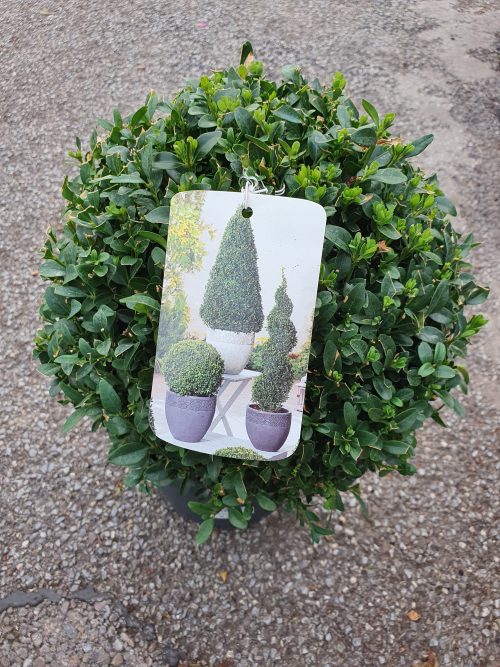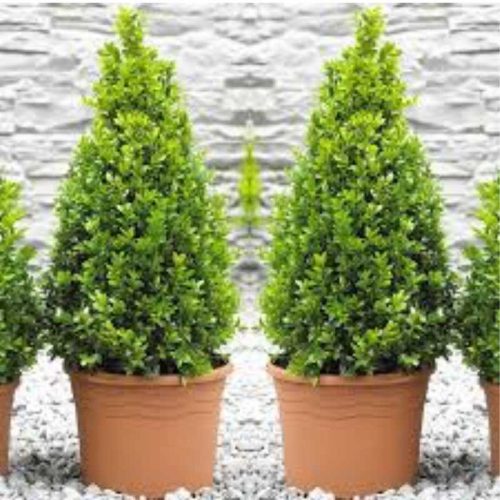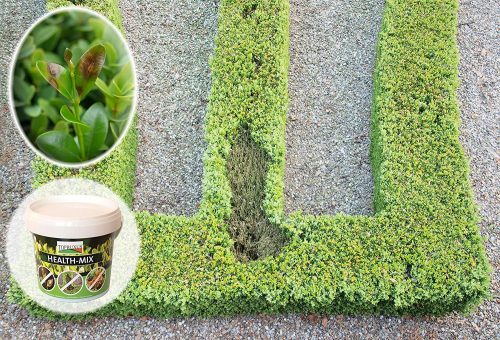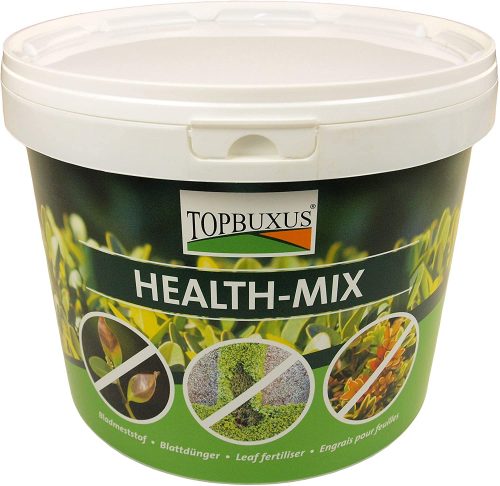TOP BUXUS HEALTH-MIX can be used in two ways.
1. For bright green shiny leaves and to prevent fungal disease, such as Cylindrocladium With TOPBUXUS HEALTH-MIX, you can give your box plants bright green shiny leaves, preventing yellow edges and faded colours.
To achieve this, treat your box plants 3-5 times during the growing season from March to October. This will also make your box plants healthier and stronger, resulting in them becoming more resistant to disease, etc.; this will particularly help to prevent fungal diseases such as Cylindrocladium.
2. To deal immediately with an acute fungal disease such as Cylindrocladium With TOPBUXUS HEALTH-MIX, you are able to immediately stop acute fungal disease such as Cylindrocladium. An acute fungal disease is immediately recognisable from the brown points that will swiftly expand to form blemishes. The most dangerous period is when there is protracted rainfall in combination with high temperatures. If you do nothing, the diseased box plant will soon start to lose its leaves and, in the worst case, if you fail to treat it, the affected branches can die, resulting in dead areas in your box plant. The diseased plants will then unfortunately have to be replaced. However, if you promptly use TOPBUXUS HEALTH-MIX after treatment, leaves will soon sprout on the diseased branches and recover. When the onset of disease is evident, immediately carry out the treatment.
Under normal circumstances, one treatment is sufficient. It is extremely important to also immediately treat all of your healthy box plants. Should the warm and damp weather persist, repeat the treatment after 1 week. Thorough inspection is recommended in the future, particularly when the weather is warm and damp for protracted periods of time. If necessary, at a later date, you can simply repeat the treatment; this means you will continue to get maximum pleasure from your box plants.
Do not use above 25 degrees Celsius. Only use early in the morning or evening in warm, sunny weather Can be used in damp weather, but preferably for use on dry foliage. If seriously affected with lots of brown spots and shedding leaves, we recommend that you first prune the plants considerably and then treat them straight away with TOPBUXUS HEALTH-MIX, which will encourage rapid regrowth



 TOP BUXUS HEALTH-MIX can be used in two ways. 1. For bright green shiny leaves and to prevent fungal disease, such as Cylindrocladium With TOPBUXUS HEALTH-MIX, you can give your box plants bright green shiny leaves, preventing yellow edges and faded colours. To achieve this, treat your box plants 3-5 times during the growing season from March to October. This will also make your box plants healthier and stronger, resulting in them becoming more resistant to disease, etc.; this will particularly help to prevent fungal diseases such as Cylindrocladium. 2. To deal immediately with an acute fungal disease such as Cylindrocladium With TOPBUXUS HEALTH-MIX, you are able to immediately stop acute fungal disease such as Cylindrocladium. An acute fungal disease is immediately recognisable from the brown points that will swiftly expand to form blemishes. The most dangerous period is when there is protracted rainfall in combination with high temperatures. If you do nothing, the diseased box plant will soon start to lose its leaves and, in the worst case, if you fail to treat it, the affected branches can die, resulting in dead areas in your box plant. The diseased plants will then unfortunately have to be replaced. However, if you promptly use TOPBUXUS HEALTH-MIX after treatment, leaves will soon sprout on the diseased branches and recover. When the onset of disease is evident, immediately carry out the treatment. Under normal circumstances, one treatment is sufficient. It is extremely important to also immediately treat all of your healthy box plants. Should the warm and damp weather persist, repeat the treatment after 1 week. Thorough inspection is recommended in the future, particularly when the weather is warm and damp for protracted periods of time. If necessary, at a later date, you can simply repeat the treatment; this means you will continue to get maximum pleasure from your box plants. Do not use above 25 degrees Celsius. Only use early in the morning or evening in warm, sunny weather Can be used in damp weather, but preferably for use on dry foliage. If seriously affected with lots of brown spots and shedding leaves, we recommend that you first prune the plants considerably and then treat them straight away with TOPBUXUS HEALTH-MIX, which will encourage rapid regrowth
TOP BUXUS HEALTH-MIX can be used in two ways. 1. For bright green shiny leaves and to prevent fungal disease, such as Cylindrocladium With TOPBUXUS HEALTH-MIX, you can give your box plants bright green shiny leaves, preventing yellow edges and faded colours. To achieve this, treat your box plants 3-5 times during the growing season from March to October. This will also make your box plants healthier and stronger, resulting in them becoming more resistant to disease, etc.; this will particularly help to prevent fungal diseases such as Cylindrocladium. 2. To deal immediately with an acute fungal disease such as Cylindrocladium With TOPBUXUS HEALTH-MIX, you are able to immediately stop acute fungal disease such as Cylindrocladium. An acute fungal disease is immediately recognisable from the brown points that will swiftly expand to form blemishes. The most dangerous period is when there is protracted rainfall in combination with high temperatures. If you do nothing, the diseased box plant will soon start to lose its leaves and, in the worst case, if you fail to treat it, the affected branches can die, resulting in dead areas in your box plant. The diseased plants will then unfortunately have to be replaced. However, if you promptly use TOPBUXUS HEALTH-MIX after treatment, leaves will soon sprout on the diseased branches and recover. When the onset of disease is evident, immediately carry out the treatment. Under normal circumstances, one treatment is sufficient. It is extremely important to also immediately treat all of your healthy box plants. Should the warm and damp weather persist, repeat the treatment after 1 week. Thorough inspection is recommended in the future, particularly when the weather is warm and damp for protracted periods of time. If necessary, at a later date, you can simply repeat the treatment; this means you will continue to get maximum pleasure from your box plants. Do not use above 25 degrees Celsius. Only use early in the morning or evening in warm, sunny weather Can be used in damp weather, but preferably for use on dry foliage. If seriously affected with lots of brown spots and shedding leaves, we recommend that you first prune the plants considerably and then treat them straight away with TOPBUXUS HEALTH-MIX, which will encourage rapid regrowth